10 THINGS TO DO IN DOWNTOWN MIAMI:
1. TAKE A WALK ON THE RIVERSIDE
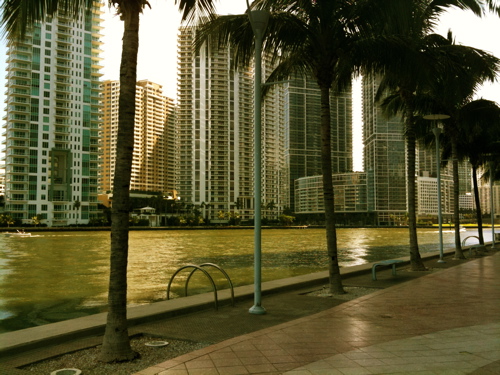
The view at the mouth of the river, looking toward Brickell Key.
Short on time? Don’t forget about the gorgeous walk by Bayfront Park, located right next to Bayside. Head toward the bay just past the Hard Rock Café and see Biscayne Bay in all its glory, with the Port of Miami in the background. Turn south, pass Bayfront Park and walk down to the mouth of the river for impressive architectural views. This walk features the work of several artists, including an impressive sculpture by Haitian-born Edouard-Duval Carrié and amazing wall drawings by Cuban-born Glexis Novoa.
While standing at the mouth of the river, gaze upon the formidable concrete jungle of Brickell Key and think of the Brickell family, pioneers who braved the swamps when the river was pristine. They traded with Indians who paddled up from the Everglades in their dugout canoes.
Continue your stroll toward Biscayne Boulevard. At the path’s end, look straight directly south across the river at Philippe Starck’s massive Icon development. Well, actually, look at the empty patch of grass by the river’s edge. You won’t be able to see it from above, but the Miami Circle is an ancient archeological site where Tequesta Indians lived over 2,000 years ago. Currently, plans are underway for construction of a beautiful city park at this location.
2. SEE IT LIKE A BIRD
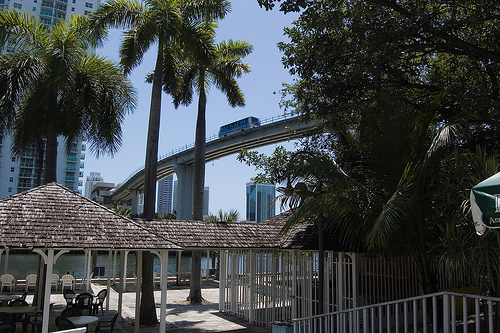
Miami’s Metromover crosses high above the river for a spectacular view. Photo taken from Bijan’s at Fort Dallas Park on the riverfront. Courtesy of DCVision on Flickr.
Take the Metromover, Miami’s light rail, free of charge. The Metromover has three loops – Omni, Downtown and Brickell: Omni takes you as far north as the the School Board, with the Miami Herald and Adrienne Arsht Center for the Performing Arts along the way; Downtown circles the business and shopping district; and Brickell travels as far south as 14th street.
There are numerous transfer stations for the different loops; you can figure out if you’re at one by observing the electronic signs above the track. There are also posted maps to guide you. You really can’t get lost though; the loops are finite and each rail car always returns to square one.
From Bayside, walk a couple of blocks west to College/Bayside station, where you’ll catch the Brickell loop and continue on to Brickell via Government Center. There’s no better way to get a bird’s eye view of Downtown and its surrounding neighborhoods. You’ll pass by many historic buildings and high over the river. Once at Brickell, simply return to Bayside or the stop of your choice. To learn more about Metromover stations, routes and hours of operation, visit Miami-Dade Public Transportation.
3. GET CULTURED
Visit the Historical Museum of South Florida or the Miami Art Museum, by far the best way to kill a couple of hours in Downtown Miami. Both institutions are located across from each other in a large courtyard, where you’ll also find the main branch of the Miami-Dade Pubic Library. Take College/Bayside station to Government Center and walk to Museum Plaza. The Historical Museum features a permanent exhibit about South Florida history that is a must for any new visitor. There are also seasonal exhibits that focus on a singular aspect of local history.
4. GO SHOPPING
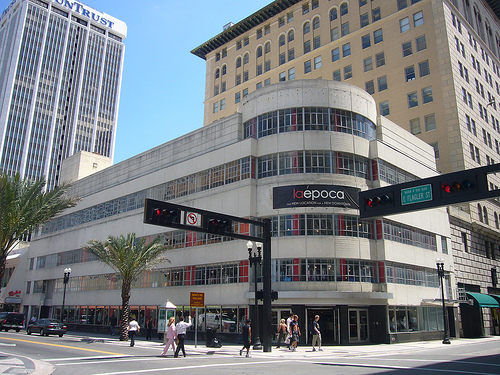
La Epoca department store. Photo courtesy of Transit Miami.
While Bayside boasts considerable retail, don’t overlook the hundreds of mom and pop shops, as well as budget chain stores, just a couple of blocks away in Downtown. Just cross Biscayne Boulevard and explore streets full of storefronts. On Flagler, you’ll find a Macy’s department store, a Ross Dress for Less and La Epoca, a multi-story department store named after its famous former namesake in Cuba. La Epoca, which specializes in men’s, women’s and children’s apparel, is housed in a 1936 streamline moderne building, the former home of a Walgreens Drug Store.
If you want to splurge on gems, stop by the Seybold Building on NE 1st street, the second largest jewelry building in the United States, with over 10 floors and 280 in-house jewelers.
5. CHECK OUT THE BIRTHPLACE OF MIAMI
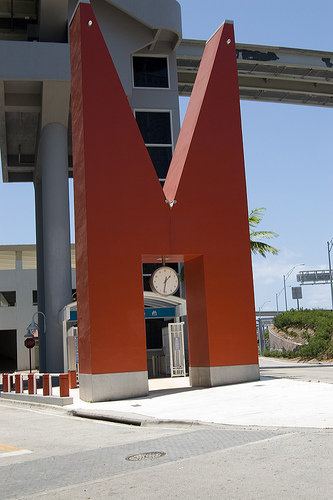
This statue begs the question: how many ways can we describe Miami with words that begin with the letter M? Photo courtesy of DCVision on Flickr.
At College/Bayside station, take the Metromover Brickell loop heading south to Riverwalk station. Stop at the high platform and enjoy the view. Then head down the elevator and see the big red M for Miami sculpture designed by local architectural artists Roberto Behar and Rosario Marquardt. While there, think of the many words that start with M that could represent Miami.
Cross the street to Bijan’s restaurant, where you’ll spot Henry Flagler’s historic yellow clapboard cottage. The structure was moved from a different location further inland where it originally housed railroad workers circa 1896.
This site is also called Fort Dallas Park, Dallas being one name for the area before there ever was a Miami. Soldiers braved the swamps here during the Seminole Wars with nothing but rustic barracks for creature comforts.
In later years, the whole area would become Julia Tuttle’s homestead. Tuttle was the mother of Miami, which is why this area of the river is considered the city’s birthplace.
The city’s exact incorporation spot, however, requires a short stroll west on SE 4th street, just past the M statue, to South Miami Avenue, where you’ll see artist’s Xavier Cortada’s living sculpture, Incorporation Palm. The palm is planted exactly where new Miamians gathered to incorporate the city in 1896. It’s not much to look at, but the site’s historical importance is quite tremendous.
6. TAKE A QUICK MIAMI RIVER AND BRICKELL TOUR
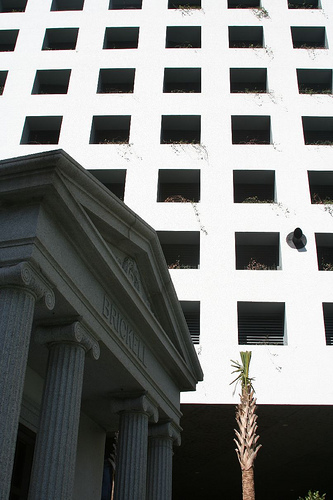
The Brickell crypt next to the imposing Icon structure. Photo courtesy of Urban City Arch on Flickr.
From Bijan’s – where you may be inclined to stop for a cold beer and a sandwich, if it’s open—stroll east on the river walk to the Hyatt Regency hotel. From there, walk up the stairs and through the lobby out to the front entrance. Then, head south over the Brickell Bridge, where you may stop to enjoy the view. (This is a drawbridge, so keep off the bridge when the tender engages the barricades.)
Note the obelisk-style statue on the east side of the bridge, dwarfed by all the surrounding buildings. The statue pays tribute to the Tequesta Indians who inhabited this territory long before the Spanish discovered Florida.
At the next crosswalk, carefully cross Brickell Avenue and head over to Brickell Park, which is just south of the Icon tower development (you can’t miss its ugly columns, which look like totems from Easter Island).
In the park, note historic First Presbyterian Church just next door and the park’s impressive trees. Make your your way to the water’s edge, where you’ll also enjoy a view of Brickell Key. You’ll encounter the Brickell family mini-crypt on your walk, but don’t worry—there are no ghosts in there. The Brickells are actually buried in Woodlawn Park. The only spooky things close by are the eerie totems spread all over Icon’s driveway.
On the way back, cross the street once again and head back to the Hyatt. Standing on the driveway by the valet station, you’ll see an empty construction site, future home of the Met 3. This was the location of Henry Flagler’s Royal Palm hotel, a luxury resort completed in 1897 to attract wealthy snowbirds to the Florida wilderness.
As you gaze at the concrete behemoths before you, marvel at how much Miami has changed in just over 100 years!
7. ENJOY A RIVERFRONT LUNCH
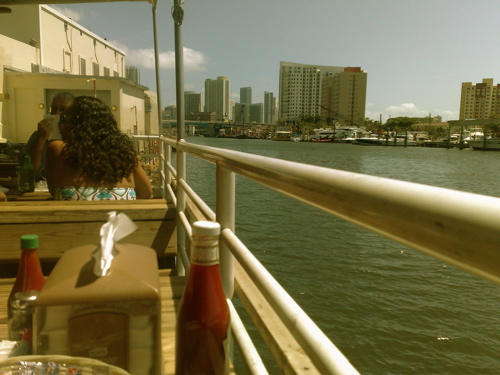
Fresh catches arrive daily at Garcia’s on the river.
At some point, you’ll probably be hungry. There a dozens upon dozens of little restaurants Downtown—too many to name here. But if you want to explore more of the riverfront, take a short cab ride to Garcia’s Seafood Grille and Fish Market for a hearty lunch featuring fresh, local catches.
Afterwards, walk just due south along the river where you’ll find historic Lummus Park. On the premises, you’ll see the original home of pioneer William Wagner. (Currently, the park is closed for renovation, but you can still see the structure.)
On this walk, you’ll also spy Miami’s weirdest looking building – the Scottish Rite Masonic Lodge. It’s hard to say what actually happens inside – unless you’re a mason. But the exterior is impressive. Bring your camera.
Make sure you take a cab back – though not far from Bayside, the neighborhood in between is rather sketchy.
8. SEE HISTORIC BUILDINGS
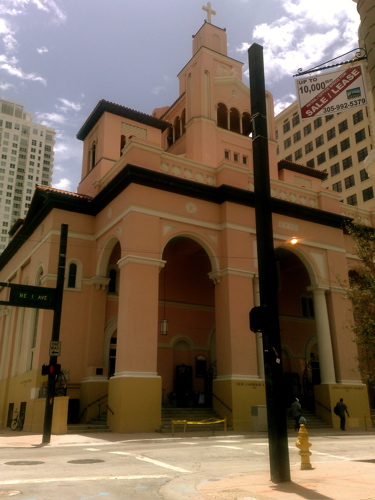
The imposing exterior of Gesu Catholic Church, a major Downtown Miami landmark located just a few blocks west of Bayside.
Just a short walk from Bayside heading southwest past Biscayne Boulevard is Miami’s oldest Catholic Church, Gesu, on NE 2nd avenue. Gesu was founded in 1896 and before Miami started sprawling west to the suburbs, much of the city’s religious life centered on this venerable institution.
Inside, on the wall by the main entrance, you’ll find a pictorial history. Note the stained glass windows, the impressive murals and organ. Outside, note the cantilevered ceiling and portico, adorned with a giant bell.
On the way there, you’ll walk through Miami-Dade College campus and pass by the old Federal District courthouse, made from ancient keystone quarried in the Florida Keys.
Other buildings nearby: the Alfred I. Dupont (check out the lobby and its beautiful elevators), the Olympia Theater (if it’s open, ask the staff if you can peek into the lobby and theater) and the Shoreland Arcade. There are many more historic buildings in the area so just keep your eyes peeled for interesting architectural details. (See link to Google map below for exact locations.)
9. FIND GOOD EATS AND DRINKS AT TOBACCO ROAD OR MARY BRICKELL VILLAGE
![]()
Perricone’s, a local favorite, features a shady outdoor area. Photo courtesy of Jeffrey Guterman on Flickr.
Visit Miami’s oldest existing watering hole and best blues bar, Tobacco Road, for great drinks and burgers. Take the Metromover from the College/Bayside station on the Brickell loop to 5th street station and walk west to South Miami Avenue. Tobacco Road will be on your left across the street, just after the bridge.
Want something fancier? Stop at the Tenth Street Promenade station where you’ll find quaint but trendy Mary Brickell Village and a handful of great restaurants just one block west around the corner. Perricone’s, a local favorite, boasts an outdoor patio shaded by a canopy of some very old Brickell trees that are part of a tiny city park. Try the pasta dishes or one of the many delicious sandwiches.
Dolores but You Can Call Me Lolita (yes, that’s the name of this restaurant) is housed in a beautifully remodeled firehouse, dated 1926. Lolita offers a lunch buffet Monday through Friday.
10. VISIT THE FREEDOM TOWER
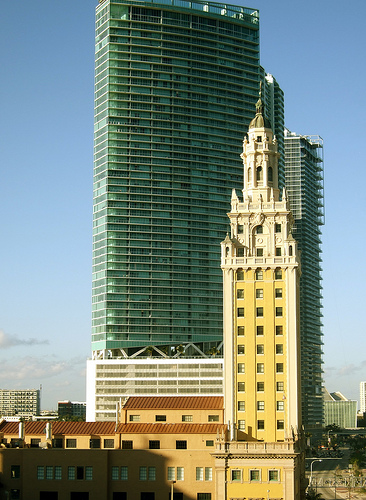
Old versus the new: The Freedom Tower looks like an elegant, old-fashioned lady next to a tower of glass and steel.
The closest historic structure to Bayside is the Freedom Tower, which was modeled after the Giralda tower in Andalucía, Spain. The former headquarters of the Miami News and Miami Metropolis, the tower got its name after it became a processing center for Cuban immigrants during the first wave of exiles in the 1960’s. Standing at Bayside’s entrance, you can’t miss this magnificent building – just cross carefully over the wide lanes of Biscayne Boulevard to get a closer look.
Downtown Miami

Locally known as Downtown, the area is a cultural, financial, and commercial center of South Florida, tracing its present-day history back to the 19th century. In recent years, Downtown Miami has grown to become the fastest-growing area in Miami, with large scale high-rise construction and population increase. Downtown is home to many major museums, parks, education centers, banks, company headquarters, courthouses, government offices, theaters, shops and many of the oldest buildings in the city.